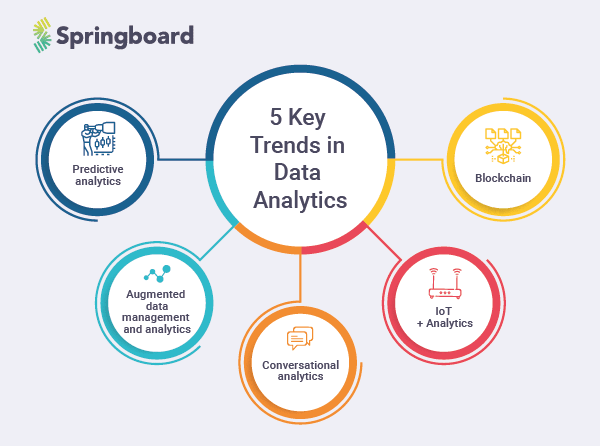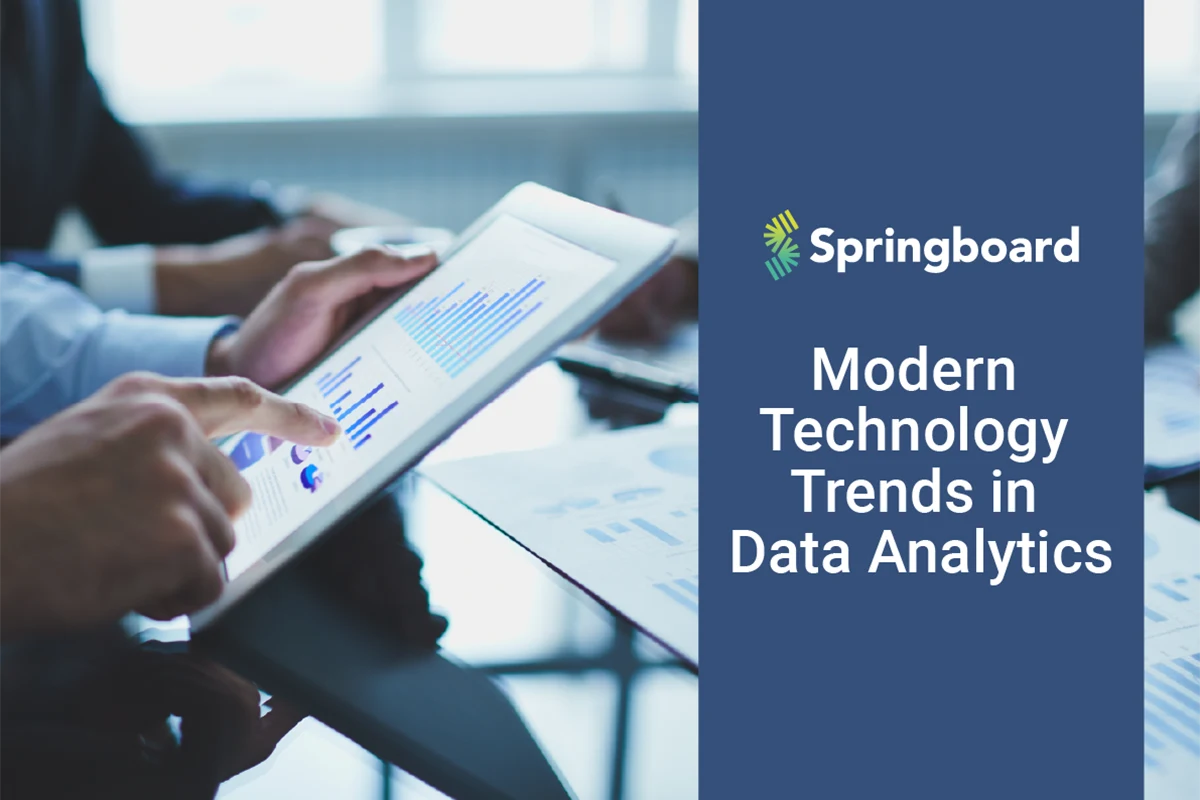Free Data Analytics Course
Jumpstart your journey with 25 essential learning units in data analytics. No cost, just knowledge.
By now, big data is no longer emerging technology — it is officially mainstream. Don’t take our word for it! The Dresner Advisory Services’ 2018 Big Data Analytics Market Study finds that big data adoption grew to 59% and continues to grow constantly. Less than 10% of enterprises have ‘no plans’ to adopt big data, meaning almost everyone is on their big data journey. As big data adoption grows, analytics becomes the natural next thing, to make sense of the data efficiently and ethically. Modern technology trends in data analytics, as they mature, will shape careers and markets in the sector. Here are some ways in which this will happen.
Modern Technology Trends in Data Analytics

1. Predictive Analytics will Become the Norm.
As the data analytics market matures, enterprises will stop using data analytics as a way to review the past. They will leverage their big data to predict the future. And it might not be as far off as you think!
Across industries, predictive analytics is already in action. Banks and financial institutions are developing analytics solutions to predict and manage risks across loans, credit cards, insurance premiums, etc. Marketers are performing data analysis to show the right advertisement to the right audience at the right place and time. Law enforcement agencies are using it in crime detection and prevention. And healthcare is using it for early disease detection — for instance, Kaiser Permanente, an insurance provider in the US, uses predictive analytics models to calculate neonatal sepsis risk in newborns, which reduces the use of antibiotics by nearly 50%.
Even today, most organizations use data analytics to analyze the past, and human intelligence to forecast the future. In 2020, data analytics will also do the latter.
Get To Know Other Data Analytics Students
Sarah Savage
Content Data Analyst at EdX
Maura Fields
Data Analyst at Northeastern University
Nelson Borges
Insights Analyst at LinkedIn
2. Modern Technology Trends: Bots will Drive Augmented Data Analytics.
One of the biggest problems with big data today is the unshakeable need for a data scientist to cleanse and prepare the data before making sense of it by building analytics and dashboards. Even with a highly-skilled data scientist, there is only so much that can be manually done, significantly restricting the capabilities of data analytics. It is here that augmented data analytics is steadily gaining ground.
Simply put, augmented data analytics is the process of using artificial intelligence (AI), machine learning (ML) and natural language processing (NLP) to augment analytics and business intelligence. And there is a lot of traction for letting bots do the grunt work, like data discovery, data management, data cleansing, categorization, managing metadata, etc. In fact, Gartner predicts that there will also be preemptive automated reports — where platforms will understand what insight might be relevant to the user and present it proactively. Who says bots can’t read your mind!
3. Voice/Speech Analytics will Gain Momentum.
Communication has already moved beyond text — memes are becoming legit forms of interaction and emojis are everywhere. The next step in the evolution of online communication is bound to be in sound and video. As voice-enabled personal assistants grow in popularity, speech analytics will play a huge role in how systems respond to voice searches; and by extension, this will have a great impact on how content is made accessible as a whole.
“By 2021, natural language processing and conversational analytics will boost analytics and business intelligence adoption,” wrote Gartner. But this corresponding prediction is a lot more relevant to data science professionals and aspirants:
By 2020, the number of data and analytics experts in business units will grow at three times the rate of experts in IT departments, which will force companies to rethink their organizational models and skillsets.
— Gartner, Magic Quadrant for Analytics and Business Intelligence Platforms, Published 11 February 2019
4. IoT will Overcome its Analytics Challenge.
The internet of things (IoT) was a big trend a couple of years ago, but it didn’t actually live up to the hype — turns out speaking refrigerators and connected washing machines don’t yet have the market they were predicted to have. But in the industrial markets, IoT has been a big hit. Across the manufacturing and supply chain, IoT is making a real impact.
As manufacturers iron out their sensors and devices, they will take the next step: Of making IoT data-driven. In the immediate future, analytics will power the increasing adoption and leveraging of IoT with ‘digital twins’. A digital twin is the virtual replica of physical devices. Data scientists and data analysts then use this replica for simulations — based on which they not only innovate and improve IoT devices but also predict future performance and make them more secure.
5. Blockchain will Clean-up Before Data Analysis.
If there is one thing that bugs data scientists the most, it’s dirty data — data that is unclear, duplicated, erroneous, etc. Professionals are bringing blockchain to address precisely this problem. Blockchain’s decentralized consensus algorithms will be used in data validation, making it cleaner, more usable, and therefore insights more reliable. Moreover, the decentralized system, coupled with cryptography, will also make data secure and protect data privacy.
These trends make it clear that data analytics as a field is maturing rapidly. From being an experimental technology just a few years ago, today, even the smallest of organizations are leveraging data analytics in one way or another. Modern technology trends in data analytics will combine with other future technologies like AI, IoT, Blockchain, Edge Computing, etc. In order to grab the thousands of data analytics career opportunities that will open up in 2020, you need more than just any education. You need mentor-led project-driven online learning programs that come with a job guarantee. Try Springboard now.
Since you’re here…
Interested in a career in data analytics? You will be after scanning this data analytics salary guide. When you’re serious about getting a job, look into our 40-hour Intro to Data Analytics Course for total beginners, or our mentor-led Data Analytics Bootcamp.






